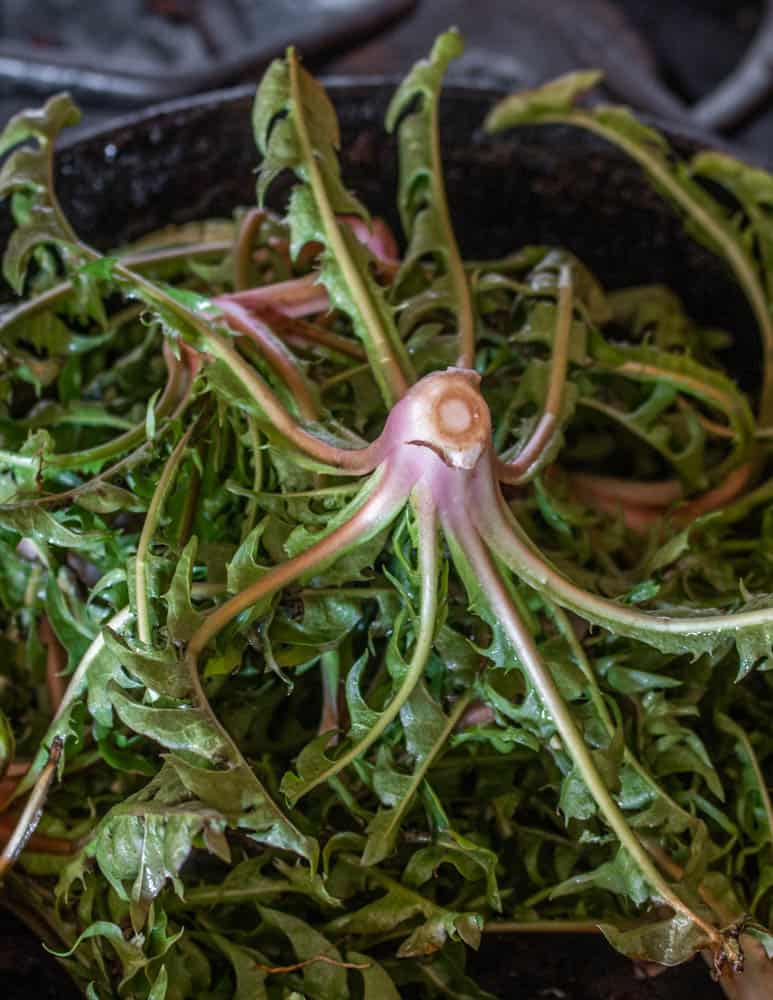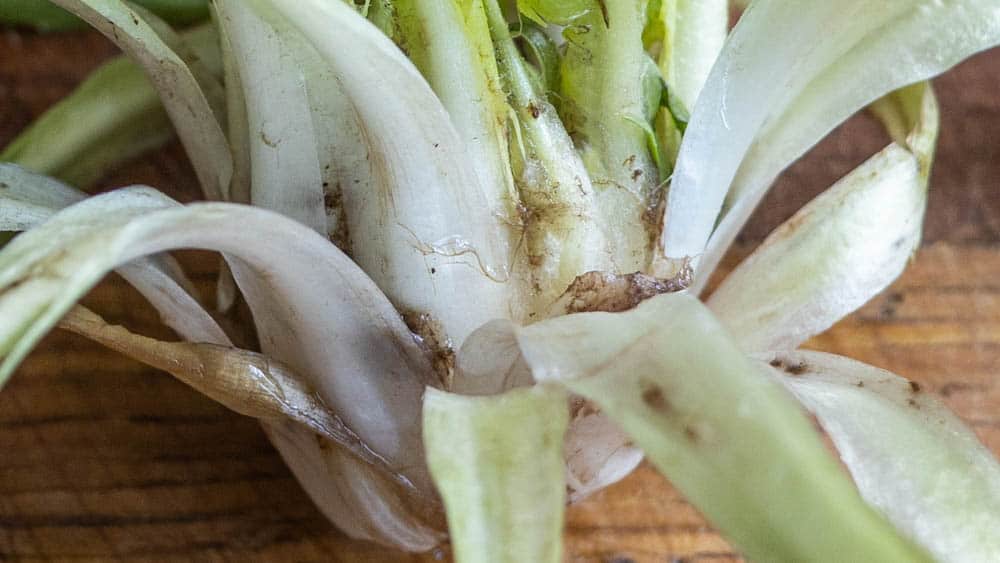About 7 years ago while I was playing disc golf, I came across an elderly women digging up dandelions near the parking lot of the course. I've always been fascinated by traditional recipes and preparations, so, of course I had to walk up and ask what she was harvesting, and how she was going to prepare it.

I'm pretty sure I spooked her a bit, and, there was a language barrier (she looked Hmong or Lao to me, but I can't be certain).

I did my best to gesticulate and inquire, but I remember her leaving pretty fast. In hindsight, if I was her, approached by some random white guy who, as far as I knew would probably poo-poo my digging up dandelions in a public park, I would have bolted too.

I didn't realize what she was actually harvesting until years later when I started cooking with whole young spinach attached to it's stem from my favorite farmer from Oregon, a great guy named George Weppler who used to supply Alice Waters in the early years of Chez Panisse.
The woman at the parking lot wasn't just foraging some dandelion greens, she was harvesting dandelion hearts (also known as crowns) and there's a big difference.

Harvest in the Spring
Dandelions are at their peak when they're young in the spring. The young rosettes are a far cry from the stronger flavor they'll develop during the growing season.
Dandelion hearts though, are the finest part I've eaten. Cooking the crowns takes a bit of work, but if you can clean a leek, potato, or carrot from a garden, you can enjoy a fantastic little vegetable any chef I know would kill to get their hands on.

I'd forgotten about the hearts until last year when I dug up the roots to try making tinctures, and, when I levered the root from the ground with that satisfying snap only a big spade can give, staring me in the face, was a bunch of fat, juicy, dandy-crowns.
I forgot about the roots and cooked a few crowns up. They were great. The leaves on the top of the plant are just long enough to twirl with a fork, and the small, tender bottom portion with it's little bit of stem has a texture that's really good. The best comparison I can think of being tiny artichoke bottoms, with a stronger flavor.

Over the course of the 2020 winter, I ran into a recipe, for dandelion crowns, in a Turkish book I've been cooking through. The recipe called for dandelions, but it instructed the cook to discard the top portion of the leaves and use the stem.
Cooked whole, with their leaves, dandelion hearts are still novel and fun, but, after a haircut (save the trimmed greens for making Lebanese Dandelions with Caramelized Onions (Hindbeh) they're transformed into a different culinary ingredient entirely that looks, at least to me, a bit like fairy fennel bulbs. Here's a few tips on harvesting and working with them

Chefs Tips
Know the terrain
The woman I met was digging around near parking lot with rocky soil-exactly the opposite of where you will find the champion dandelions you want, which will have the biggest hearts. You want rich, healthy soil that's soft and easy to dig in, if you dig after a rain they'll come up even easier.
Wild places, like open areas with sun on the edges of the woods will be good, and on the peripheries of farms that grow crops you'd like to eat. Choose the beefiest looking dandelion rosettes you can find, as those will have the biggest crowns with the largest proportion of that tender, delicious stem.

Cleaning
Dandelion crowns are dirty. My suggestion is to wash them, then wash them again, finally, to cook them, blanch them in salted water, then transfer to a bowl of warm water (cold temperatures are less conducive to loosening grit) swish them, and finally dry on towels before cooking, which is probably better described as reheating.
Only young plants will do
You must harvest the dandelion crowns when they're young, and that means when the leaves are about 6-7 inches long. Any older and the stems will be tough.


The dandelion recipe here is based around a traditional Apulian dish of wild chicory served with a puree of fava beans known in the region as Foje M'bische-a golden nugget I dug out of a book I've been translating not available in English.
In the recipe and video here, I serve it with a puree of chickpeas colored with Sam Thayer's water oak acorn oil. Traditionally the dish is made with dried fava beans.
If you can't find those (try an Asian market) mashed up chickpeas or white beans, or just some hummus will give you the idea. The combination of creamy and bitter/aster flavor is very nice. Some people add croutons fried in butter.

Pugliese Inspired Dandelion Hearts
Equipment
- 1 4 quart pasta pot for blanching
- 1 10 inch saute pan for finishing the crowns
Ingredients
Dandelion Hearts
- 8 oz trimmed and cleaned dandelion hearts / crowns
- 1.5 tablespoons flavorless oil or a blend of EVOO and cooking oil
- Good pinch of crushed red pepper flakes to taste
- ½ teaspoon anchovy paste
- 1 large clove garlic
- ⅓ cup bean puree traditionally more puree is served, but I opted for a cleaner presentation here
- Kosher salt and fresh ground black pepper to taste
- Wild flowers to garnish, optional I had a few sprigs of spring beauty
Bean Puree
- 1 15.5 oz can of chickpeas
- 3 Tablespoons acorn oil or EVOO
- 1 large clove garlic crushed with the back of a knife
- Juice of half a large lemon roughly 2 tablespoons
- Kosher salt to taste
Instructions
Lazy bean puree
- For the bean puree, pour the can of chickpeas with all their juice into a small pot and bring to a boil. Pour the hot beans and all of their juice into a highspeed blender like a vitamix or a food processor, along with the lemon juice, garlic and a pinch of salt.
- If you are using a small capacity blender, make sure there’s a vent as trapped steam from the hot beans could make the lid blow off of the machine, or let the beans cool a bit before blending.
- Blend the mixture, drizzling in the oil to make a smooth puree. If you have a vitamix, use the accelerator tool to help here. If you use a food processor, it may be difficult to get the puree as smooth as I have pictured, but it will still taste good.
Dandelions
- Wash the dandelion hearts and trim them, snipping off the top couple inches of leaves which you’ll save for another purpose.
- Bring a pot of water to a boil and season it with salt (roughly 1 tablespoon per quart). Blanch the dandelion hearts for a minute or two, then remove to a bowl of water (not ice water) and swish them around as a final defense against dirt. Remove the dandelion hearts to a towel to weep excess water.
- Meanwhile, heat the garlic in the oil in a cold pan on medium heat, stirring occasionally until the garlic is nearly golden brown. Add the anchovy paste and stir, then add the chili flakes if using. Quickly add the dandelion crowns, stirring to halt the cooking of the garlic. Stir the crowns well to distribute the flavors.
Serving
- When the crowns are heated through, check the seasoning by tasting one, adjust as needed for salt.
- Spread ⅓ cup of the bean puree (or as much as you like) on a plate and spread it out with an off-set spatula. Arrange the dandelion hearts on the top, drizzle with a little oil to finish, garnish with the wildflowers, and serve. Some variations of the dish add croutons fried in oil for texture.


Lani Soules
In early 2013, I was foraging a profuse lot next to a dog park in SE Portland Oregon when I noticed an elderly woman (a bit more so than I was at the time) also foraging.. different plants than I was. I angled over towards her and struck up a 'conversation'.. she was harvesting mainly daisies.. 'marguerites'.. she was from Romania and asked me what some of the plants she saw in my basket were called in English. We did a lot of gesturing mixed in with multiple languages in that we both spoke at least some English and French.. just as she was leaving, she told me where there was a great mass of stinging nettle just inside an obscure entrace to the Powell Butte Park. It took me several days to find it, but that entrance and trail became my primary as the main entrance to the park attracted a rather shady crew of vagrant men who did keep their distance from me and my alert large off leash dog, but still kept us on high alert. I always looked for her in both locations, but never saw her again.
Indy
I'm just a random kid who likes to eat my wild veggies, and I've been delighted by the dandelion over and over again.
I was actually shocked when I baked my first dandelion roots (slivered lengthwise and on low heat for about twenty to thirty minutes) and they came out tasting just like sweet potato crisps!
I love this post and I'm going to have to go find some more dandelions to create another batch and try your recipe!
Alan Bergo
Thanks for commenting Indy. I've never eaten the roots like that.
Janet
I'm a gardener and a sometimes forager. I dug a bunch of dandelions out of my garden beds yesterday, and harvested the roots and the crowns. I'm going to try this recipe tomorrow. the roots were easier to clean than I expected--I didn't keep the bunchy ones--just the nice thick taproots. The thin skin scrapes off easily. I read that you can cook them like carrots--so I will try that too, maybe with some maple syrup. The most exciting things I have found foraging are giant puffballs--found one the size of a volleyball--morels, chanterelles, fern shoots and wild asparagus. For years there has been a vacant space where I live--just on the "country" edge of Winnipeg--which has abundant wild asparagus. In half an hour, I would find a couple meals worth of asparagus every few days in the spring. Just this winter, the land was sold and a monster house is being built on the property. Bye bye asparagus! Last year, I foraged there while a deer lay down watching me--not moving, not afraid. You are so right about how life-giving the time in nature is to one's soul.
Alan Bergo
Hey Janet, yes, development has cost me a lot of patches of wild food over the years. The last one was my favorite shaggy parasol patch. Have fun with the dandelion crowns-they're so much fun.
Renee west
Just tried them yesterday, been eating dandelion leaves (early spring ones) for a long time now but didn't know about the crown part. At first, do I really like these? Hmmmm, yes. I love them! Question though, what about the flower buds attached?
Renee west
NM, delicious.
Alan Bergo
I'm confused as to the question about flower buds. I eat them, yes. I also eat them unopened on the flower stems.
Mary Lacer
Great video Alan. Would love to see more. I'm anxious to try your recipe. We have plenty of dandelions already so no shortage of hearts to find. Thanks!